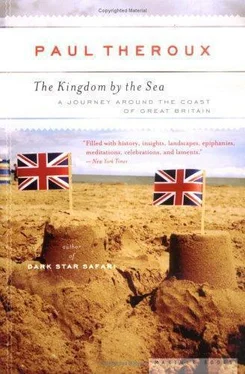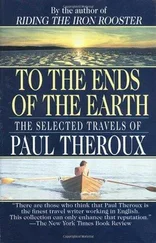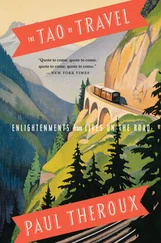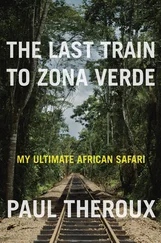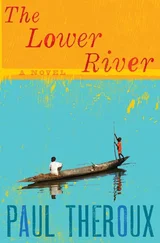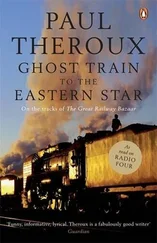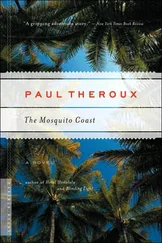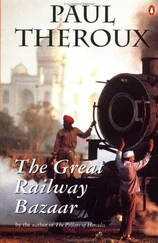It would have taken more than a week to walk from Mallaig to the Kyle of Lochalsh, up the coast. So I sailed there in the ferry Lochmorar, twenty-three miles along the Sound of Sleat. The boat passed more of these remote cottages. It said something about Scottish self-reliance and toughness that people willingly lived in such difficult places. In the whole of Britain there could not have been houses more inaccessible than these scattered over the shores of the Western Isles. The Scots here chose a distant ledge or a remote shore, and put up a stone house, and slammed their door on the world.
The coast had deep inlets and high cliffs, and it was so strange and steep, it had the effect of concentrating travelers in specific places. On this boat, for example. Or on certain valley roads. In Fort William and Oban and Mallaig. In England and Wales people were quickly absorbed by the countryside, and the coastal towns could seem very empty. But here in Scotland the countryside and the coastal steepness were forbidding, so everyone traveled on a few routes — and they had always traveled on those routes. The traveler to Mull had to go to Oban, just like Doctor Johnson and Boswell in 1773.
At the Kyle of Lochalsh I crossed to Skye, on the ferry to Kyleakin ("from Haakon, King of Norway, who sailed through here in 1263") and walked the empty roads to Broadford, eight miles. I stayed and climbed partway up a red mountain merely to have another glimpse at the Cuillins. I did not go any closer. I wanted to save them for another time. It was always a surprise and a pleasure to find a place on the British coast that I wished to return to. It gave me hope, because I knew I would not come back alone. I wanted to come here again with someone I loved and say, "Look."
The sun on Skye warmed the pines and the flowers and gave it the fragrance of Nantucket.
***
The way between the huge simple mountains and cold lochs, from the Kyle of Lochalsh to Dingwall, was one of the great railway routes of Britain. It took me off the coast, but what else could I do? The northerly shore was broken and labyrinthine. It would only be a stunt to follow every mile of it, just to report on Loch Snizort and Trotternish. And the train was a greater temptation. Anyway, many of these lochs were also notches on the coast. Loch Carron, for example — the south bank, on which this train was traveling — was sixteen miles of coast.
Nothing looked to me colder than the Scottish lochs, and they seemed to become colder still as the clouds piled up and night deepened. But these were short nights — a few cloudy hours of wintry light, and then morning. It was eight o'clock, and every landscape feature was clearly visible — the water, the hills, the tree farms, the long valley floor of Glen Carron, which seemed to be covered with grassy mounds — tombs and tumuli.
"Ach, some of these villages have been here since the year dot," a man named Macnab said to me. Yes, they had a mossy, buried look. But many looked bleakly exposed, plopped down, and untidy — no hedges, no bushes — the bushiest thing in Achnasheen was the stationmaster's beard.
We were delayed at Garve. I thought: I'll give it an hour, and if we're still here I'll get off and walk up the Black Water or hitch to Ullapool. (Delays always sent me to my map for an escape route.)
Malcolm Biles asked for a look at my map. He was twenty-three, a post office clerk from Inverness who was on a cheap day-return. I had wanted to meet a post office worker, I told him. British post office workers did much more than sell stamps. They processed car licenses, television licenses, Family Allowance, pensions, Inland Telegram postal orders, all the tasks required by the Post Office Savings Bank, and a hundred other things. They had seven weeks' training, and the rest had to be learned on the job, in full view of the impatient public. It was Malcolm who spoke of the impatience — people were much ruder than they used to be and some of them stood there and ticked you off!
"What about dog licenses?" I asked.
Dog licenses! It was Malcolm Biles's favorite subject. The price of a dog license was 37½ pence (about sixty cents), because in 1880 it had been fixed at seven shillings and sixpence. The fee had never been changed. Wasn't that silly? I agreed it was. There were six million dogs in Britain, but only half of them were licensed. But the amazing thing was that it cost £4 (almost $7.00) to collect the dog license — the time, paperwork, and so forth.
"Why not abolish the fee?" I asked.
Malcolm said, "That would be giving up."
"Why not increase it to something realistic — say, five quid?"
"That would be unpopular," he said. "No government would dare try it."
"How long do you figure you'll be staying in the post office?"
"For the rest of my life, I hope," he said. The train jolted. "Ah, we're away."
I tried to imagine a whole lifetime in a post office. I could not imagine it. I got to the end of a few years and then nothing would come — a blur, fatigue, bewilderment, indifference. It was easier to imagine the life of that crofter talking gently to his dog at Strath-peffer.
Still, we discussed the post office and debated the issue of dog licenses until we came to Dingwall ("birthplace of Macbeth").
19. The Flyer to Cape Wrath
MY BLUE GUIDE'S description of the northwest coast of Scotland suggested a setting that was straight out of Dracula or The Mountains of Madness. "The road crosses a strange and forbidding mountain wilderness," it began, "of sombre rock-strewn glens, perched glacial boulders, and black lochs." And then, "after 8 m. of lonely moor and dark bog… the road from the ferry's w. end to Cape Wrath crosses a bleak moor called The Parph, once notorious for its wolves," and at last, "the road rises across a desolate moor…"
It made me want to set off at once. It seemed the perfect antidote to the Presbyterian monotony of Dingwall. If the guidebook's description was accurate, it would be like traveling to the end of the world — in any case, the British world. Cape Wrath was not merely remote — the ultimate coastline — it was also such a neglected place and reputedly so empty that the method for getting there had not changed for eighty years or more. Baedeker's Great Britain for 1906 said, "From Lairg, mail-cart routes diverge in various directions, by means of which the highly picturesque country to the W. and N.W…. may be conveniently explored…"
At Dingwall Station I asked the best way to Cape Wrath.
"Get the post bus at Lairg," Mr. MacNichols said.
In other words, the mail cart. There was no train, there was no bus, there was hardly a road — it was paved the width of a wagon for fifty-six miles. There were people who still called the post bus "the flyer," as they called tenant farms "crofts" and porridge "crowdie."
The train to Lairg left Dingwall and passed along the edge of Cromarty Firth, which at this state of the tide was shallow water seeping into the mudflats. Not long before, the railway line was to have been shut down, but it had been reprieved. It passed through the bleakest, boggiest part of Caithness, where the roads were often bad, and in winter it was an essential service. But Mr. MacNichols had confided to me that in the off season there were sometimes only three or four people on board.
To save money on the line, some of the stations had been closed. The ruined, boarded-up station building at Alness resembled many I had seen in Ulster. A large aluminum smelter had just closed at Invergordon — nine hundred more people out of work and another building left to rot. Decrepitude was decrepitude — the fury of terrorists was indistinguishable from the willfulnes of budget-cutters and accountants.
Читать дальше
